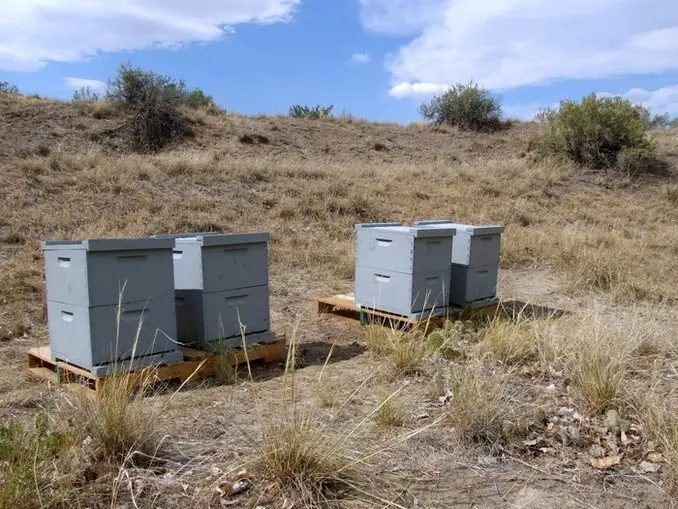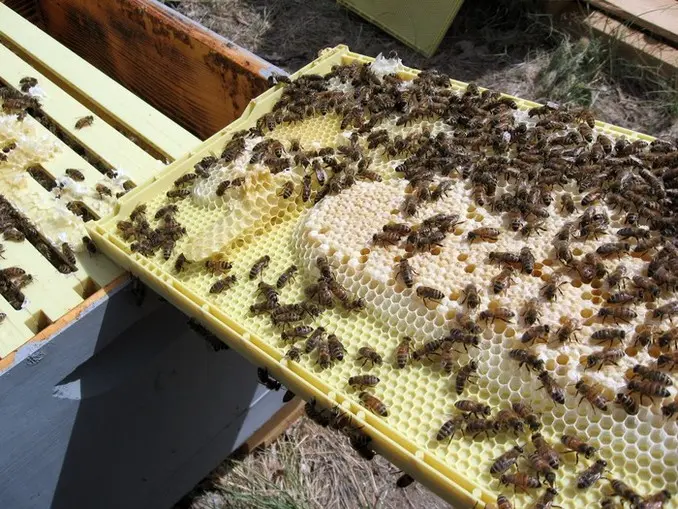Year 5 June - Buzzing with Four Hives 🖊️

-Narrowing it down to four hives.
Down to Four - A Wyoming Bee Tale
So, here’s the latest buzz: these bees are the real deal, true Wyoming bees, raised on nothing but small cell-sized comb. As for those California bees brought up on conventional foundation-based comb? Well, sadly, they’ve met their end.
- PF-100 frames? The bees love ’em.
- Hives buzzing around 8 to 9 frames.
- Witnessed the debut of the first drone comb.
- Decided to throw in a second deep hive body.
- Time to remove entrance reducers.
- Oh, and a queenless hive? Had to shake things up a bit.
With the spring moisture playing hard to get, forage is fading fast. Looks like we’re in for another round of drought.
Mann Lake’s PF-100 Plastic Frames
Hive populations? Doubled. And these bees haven’t missed a beat, drawing out the perfect small cell-sized comb on those PF-100 frames from Mann Lake. Can we give them a round of applause?
Using the PF-100s was a breeze – cost-effective and efficient, a real win over the wax-based small cell foundation.
Space
Picture this: Brood boxes stacked with unmodified PF-100 frames were perched on top of the singles. Entrance reducers? Tossed out. We’re now talking hive doubles.
- Bees showing major love for the 1 1/4″ wide frames.
- Brood nest expanding horizontally into the new box above.
Comb

-Spotted some drone comb on a small cell plastic frame.
After drawing out 6 to 8 frames of that perfect small cell-sized comb, the bees decided it was time for a little drone action.
Since the plastic cell size couldn’t be altered, small sections of comb, about two fingers wide, were shifted away from the foundation to make room for larger cells.
- Only specific sections per hive got this makeover.
- Small cell comb continued to be a masterpiece elsewhere in the hive.
This dance with drone comb echoes past experiences with beeswax-based small cell foundation. But here’s the twist – with wax foundation, when bees decided on drone comb, they’d revamp entire frames of previously drawn small cell comb, creating quite the mess for the beekeeper.
Now, if the bees are content with this tiny bit of drone comb on the PF-100s, it’s all good.
Done Gone
One hive decided to go queenless. No drone laying, nada. She vanished.
Did I accidentally bump her off during an inspection? Impossible to say. But going by my commercial beekeeping days, losing a hive before winter wasn’t exactly unexpected.
So, no more eggs or little larvae. And time’s running out for them to raise a new queen and build up enough to brave the winter. These queenless bees got the shake-out treatment. And the drawn comb and brood? Shared the love with the other hives. It’s still early days for these bees to find a new home without sparking a full-on bee war.
Drought
Hate to be the bearer of bad news, but it’s official:
- The prairie hasn’t greened up.
- Not a single baby antelope in sight.
- Spring runoff from the mountains? Didn’t happen.
- The weather? More like July than June.
Normally, I’d move the bees near agriculture by July. But during a drought:
- Limited irrigated fields become hotspots for prairie grasshoppers.
- Alfalfa gets an earlier and more frequent trim, often with a sprinkle of spray.
- Between alfalfa cuttings, there’s practically nada for the bees to work.
- Limited water sources get a dose of spray to tackle West Nile Virus.
I’m debating whether to keep them put. Maybe leave them near town and next to the river. Perhaps there’s more clover and plant diversity there. At least they’re away from heavy-duty spraying.
Here’s to the bees and hoping for rain – lots of it! ✨
-Cheers, D 🍂🐝
